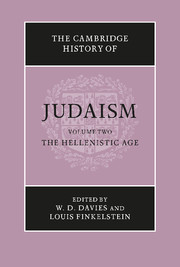Book contents
- Frontmatter
- 1 The archeology of Hellenistic Palestine
- 2 The political and social History of Palestine from Alexander to Antiochus III (333–187 B.C.E.)
- 3 Hebrew, Aramaic and Greek in the Hellenistic age
- 4 The Diaspora in the Hellenistic age
- 5 The interpenetration of Judaism and Hellenism in the pre-Maccabean period
- 6 The men of the Great Synagogue (circa 400–170 .b.c.e.)
- 7 Pharisaic leadership after the Great Synagogue (170 B.C.E.–135 C.E.)
- 8 Antiochus IV
- 9 The Hasmonean revolt and the Hasmonean dynasty
- 10 Jewish literature in Hebrew and Aramaic in the Greek era
- 11 Jewish–Greek literature of the Greek period
- 12 The Apocrypha and Pseudepigrapha of the Hellenistic period
- 13 The book of Daniel
- 14 The matrix of apocalyptic
- 15 The Septuagint and its Hebrew text
- 16 The Targumim
- 17 The Samaritans
- 18 The growth of anti-Judaism or the Greek attitude towards the Jews
- Bibliographies
- Chronological table
- Index
- References
9 - The Hasmonean revolt and the Hasmonean dynasty
Published online by Cambridge University Press: 28 March 2008
- Frontmatter
- 1 The archeology of Hellenistic Palestine
- 2 The political and social History of Palestine from Alexander to Antiochus III (333–187 B.C.E.)
- 3 Hebrew, Aramaic and Greek in the Hellenistic age
- 4 The Diaspora in the Hellenistic age
- 5 The interpenetration of Judaism and Hellenism in the pre-Maccabean period
- 6 The men of the Great Synagogue (circa 400–170 .b.c.e.)
- 7 Pharisaic leadership after the Great Synagogue (170 B.C.E.–135 C.E.)
- 8 Antiochus IV
- 9 The Hasmonean revolt and the Hasmonean dynasty
- 10 Jewish literature in Hebrew and Aramaic in the Greek era
- 11 Jewish–Greek literature of the Greek period
- 12 The Apocrypha and Pseudepigrapha of the Hellenistic period
- 13 The book of Daniel
- 14 The matrix of apocalyptic
- 15 The Septuagint and its Hebrew text
- 16 The Targumim
- 17 The Samaritans
- 18 The growth of anti-Judaism or the Greek attitude towards the Jews
- Bibliographies
- Chronological table
- Index
- References
Summary
Great and sudden were the changes which the Hasmonean family brought to the character and religion of the Jews. Yet the members of the family never saw themselves as breaking with tradition. Their first revolutionary acts were in response to an unprecedented challenge, the persecution of the Jews by Antiochus IV, and they always took the patterns for their deeds from Scripture. To understand the changes which the Hasmoneans brought, we must consider what most believing Jews then seem to have taken for granted.
To judge by the surviving literature, all believing Jews then accepted as true the books of the Torah and the prophets. The teachings of the prophets kept pious Jews loyal to their God even after the disaster of 586 b.c.e. Their God had not been defeated when Jerusalem and the Temple were destroyed. Rather, their almighty God was punishing them for their sins when he placed them under foreign domination. Prophets taught the Jews that refusal to accept God's sentence upon them would bring catastrophic punishment, as when Zedekiah's refusal to accept the sentence of subjection to Babylonian rule had brought the destruction both of God's Temple and of Zedekiah's kingdom of Judah.
The Jews in their long years of submission were indeed a peculiar people. There could be misguided hot-heads among them, but the nation never rebelled. Even the fall of Babylon did not end the sentence, though one might have thought so on reading Isaiah 40 to 66. Rather, instead of liberating Israel, God gave to Cyrus of Persia and his successors ‘all the kingdoms of the earth’, and though independence and glory would eventually be restored to the Jews, it would come not by their own ‘might and power’ in rebellion, but only through the act of the ‘spirit’ of the Lord.
- Type
- Chapter
- Information
- The Cambridge History of Judaism , pp. 292 - 351Publisher: Cambridge University PressPrint publication year: 1990
References
- 18
- Cited by



